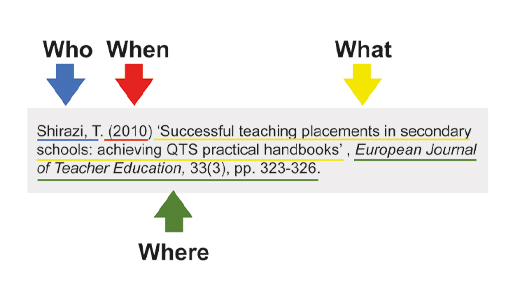2.1 Personal and professional audit trails
You might recall once upon a time playing the ‘supermarket game’. The first player starts off with ‘I went to the supermarket and bought…’. The next player continues with ‘I went to the supermarket and bought…’, only this time, the player must include what the first player bought before adding what they themselves bought. Whilst testing one’s memory and ability to quickly think of alphabetical supermarket items, this is a fantastically simple game that illustrates the notion of ‘giving credit’ to the ‘buyers’ of each food item. In ‘packing your trolley’ as it were, you must account for each player’s item.

Similarly, when you write for academic purposes, you are not only permitted but often encouraged to draw upon the works of others. For example, you may have come across the quote attributed to Isaac Newton in 1675, ‘If I have seen further it is by standing on the shoulders of giants’ (quoted in Billings, 2018). Every scientist builds on the work and understandings developed by other scientists. However, you must remember to acknowledge whose words, or whose items, you are ‘packing’ into your arguments.
Compiling an audit trail applies across all disciplines. For example, for any prospective lawyers, the idea of ‘practical legal research’ will be a skill fundamental to study and practice. Quite often, to develop that skill, law students will face a task whereby they have to construct the answer, moving from source to source to ensure any updates are covered. This ‘trail’ requires such findings to be logged so that, at any given time, if prompted or challenged on what an authority for such a statement is, it can be shown accordingly. Developing this audit trail is imperative.
Hopefully, these two simple examples illustrate the idea that an audit trail approach helps clearly illustrate where your material has been obtained from. This helps illustrate your wider reading as well as allow you to return to those sources for further information. It helps your reader look to your sources.
The term ‘plagiarism’ can be scary to hear, but one of the aims of this course is to break the stigma associated with it. Avoiding plagiarism is not only easy, but also an important skill. It is perfectly appropriate to use information from other sources when you are constructing your arguments. However, it is important to not only express the points in your own words, but to also provide the audit trail (i.e. provide references) so that the reader always knows who is saying what, and when and where they said it. Make it clear to your reader when you are using your academic voice and when you are using the words from others.
Figure 1 illustrates an academic audit trail, demonstrated by a full reference.
In this session, try not to get ‘bogged down’ by worrying about which part of your reference (if any) needs to be in bold or italics. Instead, focus on the key elements needed to help your reader find the original source. Your tutor will be able to guide you on the specific style requirements of your course.

